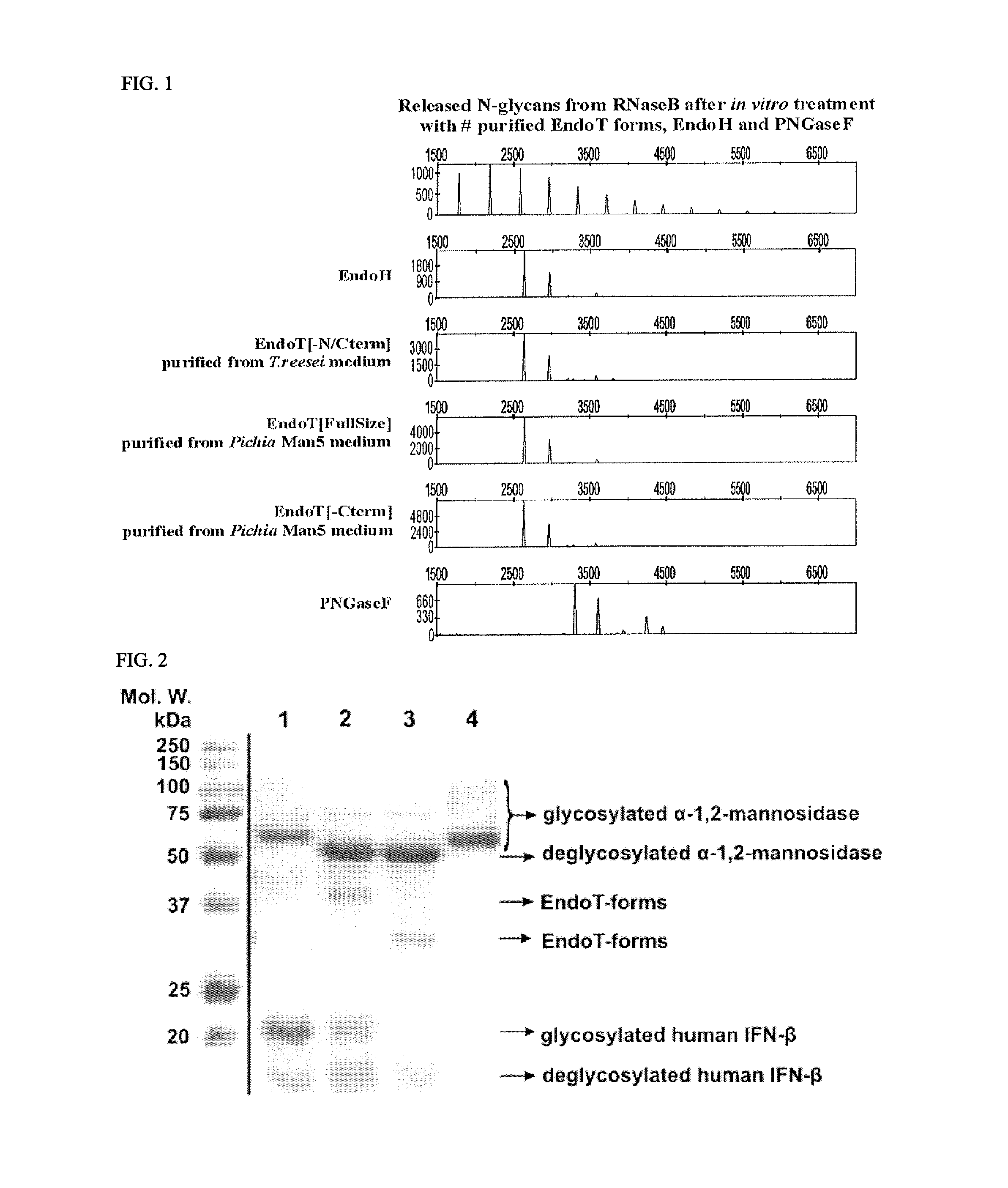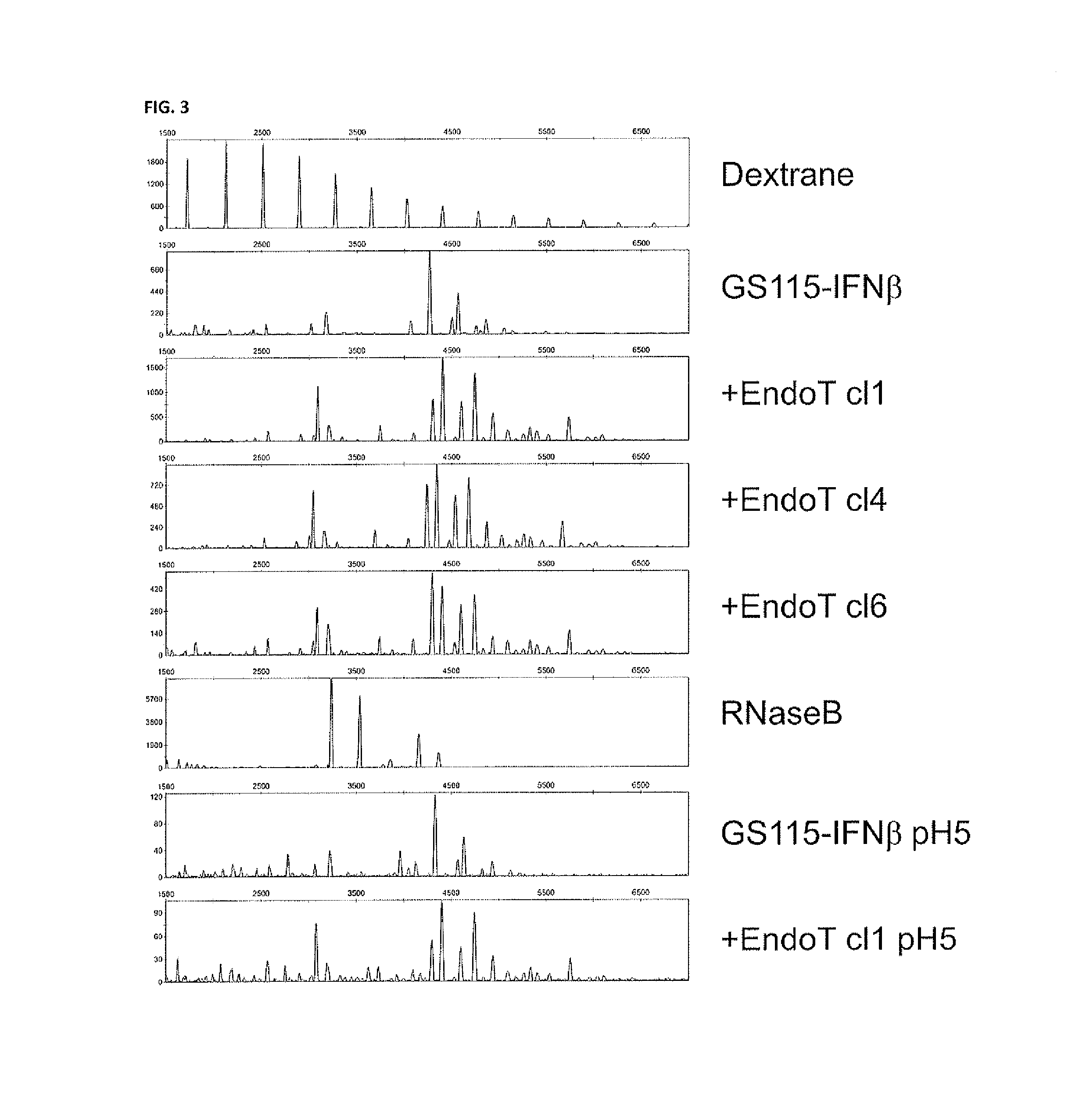Cells producing glycoproteins having altered glycosylation patterns and method and use thereof
a glycoprotein and cell technology, applied in the field of eukaryotic cells, can solve the problems of cell membrane weakening and cell lysis, and achieve the effects of reducing the number of undesired glycosylation products, and facilitating the isolation of desired glycoforms
- Summary
- Abstract
- Description
- Claims
- Application Information
AI Technical Summary
Benefits of technology
Problems solved by technology
Method used
Image
Examples
example 1
Intracellular and Soluble Expression of a Trichoderma reesei endo-N-acetyl-β-D-glucosaminidase (EndoT)) in Pichia pastoris
Introduction and Strategy
[0124]Saprophytic filamentous fungi produce and secrete a variety of hydrolases, needed for the degradation of organic material. In particular, organisms secreting cellulases and hemicellulases are of great interest to the biotechnological industry and can be used in degradation of biomass for e.g. bio-fuel production. One of the best producers of such enzymes is Trichoderma reesei.
[0125]It was shown previously that the glycosylation pattern on T. reesei secreted proteins varies considerably depending on the environmental conditions. Many of the differences in glycosylation are attributable to post-secretory trimming events by extracellular hydrolases, either becoming post-translationally activated or being differentially regulated on transcription level because of the applied growth conditions. Very peculiar in this sense, is the prese...
example 2
Production of Single GlcNAC-Modified Proteins in an Engineered Yeast Strain
[0158]Pichia pastoris strains are available which have been extensively engineered to produce complex-type human bi- and multiantennary N-glycans. These glycans can moreover be sialylated through incorporation of a CMP-N-acetylneuraminic acid synthesis pathway in the yeast cell, together with a transporter for CMP-NANA from the cytoplasm to the Golgi lumen, and α-2,6-sialyltransferase. As an example, we work with Pichia pastoris expressing human interferon-beta as described in example 1, in which the OCH1 gene has been inactivated and in which Trichoderma reesei α-1,2-mannosidase, fused to a C-terminal HDEL-tag has been overexpressed, and in which also human N-acetylglucosaminyltransferase I catalytic domain fused to the N-terminal region of S. cerevisiae Kre2p, Drosophila melanogaster Mannosidase II catalytic domain fused to the N-terminal region of S. cerevisiae Mnn2p, human N-acetylglucosaminyltransferase ...
example 3
Co-Secretion of Endoglucosaminidase and Glycoprotein by Glyco-Engineered Yeast
[0163]In this example, the setup of the experiment is entirely parallel to the one of Example 2, except that now we engineer the complex-type glyco-engineered hIFNβ-producing strain with an expression construct for the secretion of endoT protein, as detailed in example 1 (where it was done in non-glyco-engineered yeast). In this fashion, endoT enzyme and hIFNβ are cosecreted in the culture medium of the yeast. As we buffer the medium at pH=6.7 and as the pH optimum for endoT enzymatic activity is around 5.0, endoT is only very poorly active during the cultivation period, thus not affecting the physiology of the yeast. Upon completion of the hIFNβ production, the culture medium is harvested and the pH is shifted to 5.0 through double dialysis to NaAc pH=5.0 through a 3000 Da MWCO dialysis membrane. The preparation is subsequently incubated at 30° C. and samples are taken after 1 h, 2 h, 4 h and 16 h for pro...
PUM
| Property | Measurement | Unit |
|---|---|---|
| pH | aaaaa | aaaaa |
| pH | aaaaa | aaaaa |
| pH | aaaaa | aaaaa |
Abstract
Description
Claims
Application Information
 Login to View More
Login to View More - R&D
- Intellectual Property
- Life Sciences
- Materials
- Tech Scout
- Unparalleled Data Quality
- Higher Quality Content
- 60% Fewer Hallucinations
Browse by: Latest US Patents, China's latest patents, Technical Efficacy Thesaurus, Application Domain, Technology Topic, Popular Technical Reports.
© 2025 PatSnap. All rights reserved.Legal|Privacy policy|Modern Slavery Act Transparency Statement|Sitemap|About US| Contact US: help@patsnap.com



